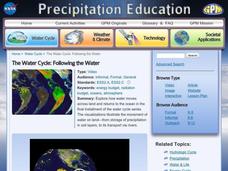American Chemical Society
The Chemistry of Fireworks
Experiment with chemical compounds to produce the colors in fireworks! The lesson instructor demonstrates how adding high temperatures to specific compounds creates a colorful reaction—the same one people use to create fireworks. This is...
American Chemical Society
How Does Tylenol Work? The Truth Is—We Don't Know
Surprise—even pharmacists don't know how Tylenol works! An installment of the ACS Reaction series considers three theories that explain the function of acetaminophen, the ingredient in the popular pain reliever Tylenol....
American Chemical Society
We Are Made of "Star Stuff"
Explore the validity of a famous quote by Carl Sagan, "We are made of star stuff." An episode of the ACS Reactions playlist explains how deteriorating stars became the origin of all the elements in our world. Learners consider different...
American Chemical Society
What Happens When You Eat Too Much?
Overeating has both physical and mental consequences. Scholars learn the body's reaction to eating and how it determines when enough is enough. The installment of the ACS Reactions playlist explores both physiological and neurological...
American Chemical Society
What's the Deal with Acne?
Use science to treat acne outbreaks! Scholars learn the immune response that creates their dreaded pimples. An ACS Reactions video lesson explains how bacteria and white blood cells interact to create these blemishes and how hormones...
American Chemical Society
Did Comets Kickstart Life on Earth?
Care to speculate on how life on Earth came to be? The video presentation from the ACS Reaction series considers the possibility of comets creating the right conditions for the formation of life. Scholars consider colliding comets as...
American Chemical Society
Can I Still Eat This?
The United States sends 133 billion pounds of edible food to landfills every year. A lesson from the ACS Reaction series discusses the chemical reactions that cause food to change over time. Some reactions make food taste different while...
American Chemical Society
The Cold Truth About Fat
Our bodies store two types of fat: brown fat and white fat—and brown fats are actually efficient at burning calories! An episode of the ACS Reaction series compares exercise generating brown fat to shivering cold. It turns out 15 minutes...
American Chemical Society
Does Cough Medicine Really Work?
There is no good evidence supporting the effectiveness of cough medicine. Although marketing and consumerism leads to a billion dollar industry, research does not show consistent results. An episode of the ACS Reaction series explores...
American Chemical Society
What Is Your Snot Saying?
All mucus is not created equal! An ACS Reactions video lesson explains what the color and texture of mucus communicates. Its appearance can indicate the status of our immune systems as it contains important cells and chemical compounds...
American Chemical Society
Vertical Farming
Create a vegetation high rise! Scholars study the trend of vertical farming and the requirements needed for a successful crop. The lesson from the ACS Reactions series explores the advantages and disadvantages in relation to traditional...
American Chemical Society
The Chemistry of Redheads
Redheads have genetic modifications that affect their pigmentation; however, the differences don't stop there! Use the video lesson from the ACS Reaction series to examine different traits specific to redheads. Learners consider...
American Chemical Society
How Do We Tell Temperature?
Explore the science behind thermometers. Rather than measuring temperature, thermometers track the movement of heat from hot to cold. The installment of the ACS Reactions series examines the chemical response that make thermometers work.
American Chemical Society
What Do Electrolytes Actually Do?
Why is your sweat salty? An episode of the ACS Reactions series examines the role of electrolytes in our systems. The narrator explains how the salts of electrolytes work in the nervous system. When we lose those electrolytes through...
Veritasium
Water on the Moon?
The surface of the moon routinely reaches 253 degrees Fahrenheit. Scientists around the world believed these high temperatures made water on the moon impossible—but they were wrong! Enlightening videos in the Veritasium playlist explore...
Veritasium
The Bayesian Trap
Explore an alternative world perspective. Scholars learn the importance of perspective in order to not fall victim to the Bayesian trap. They witness evidence that may alter their current thought processes while watching this episode of...
Veritasium
The Sun Sneeze Gene
Do you sneeze when you go from dark to light areas? Twenty-five percent of the population does! It turns out that the characteristic is due to genetic code. Explore why this happens with a video from the Veritasium playlist that...
Kurzgesagt – In a Nutshell
The Beginning of Everything—The Big Bang
How can something come from nothing? The Big Bang Theory has an answer to that question. An installment in the Kurzgesagt playlist outlines the theory of the origin of the universe. It includes an explanation of the evidence that...
NASA
The Water Cycle: Following the Water
Water that leaves the oceans must eventually return. The animations in the final lesson of the four-part NASA series show the complex path water can take across landforms before returning to the ocean. Approximately one-third of the...
NASA
The Water Cycle: Watering the Land
The oceans contribute 37 trillion tons of water to land masses in the form of rain and snow. The third in a four-part series from NASA show satellite animations highlighting the precipitation on Earth. The videos show the movement of the...
NASA
The Water Cycle: Steaming the Air
How does water vapor move from point A to point B? The second installment in a series of four on the water cycle allows scholars to analyze satellite images to answer this question. The satellite animations show how evaporation and...
NASA
The Water Cycle: Heating the Ocean
There is more to the water cycle than simply rain and evaporation! The first installment in a four-part series explores the solar heating of the ocean through three satellite animations. The animations offer different views of the earth...
Veritasium
Galaxies From Nothing
Space can never be truly empty because fields occupy the seemingly empty space. Another installment of the Veritasium playlist attempts to explain the science of the creation of the galaxies. By referencing the quantum fluctuations, the...
Veritasium
The Best and Worst Prediction in Science
To use or not use virtual particles—how will your class decide? An episode of the Veritasium playlist explains the controversy of using virtual particles. Although referencing particles seem useful, their behavior is much different than...























